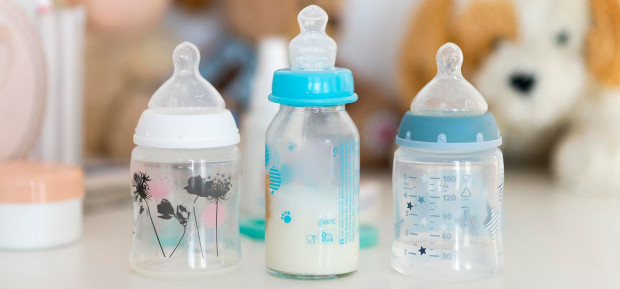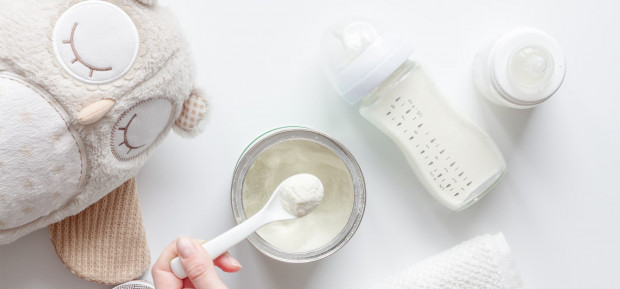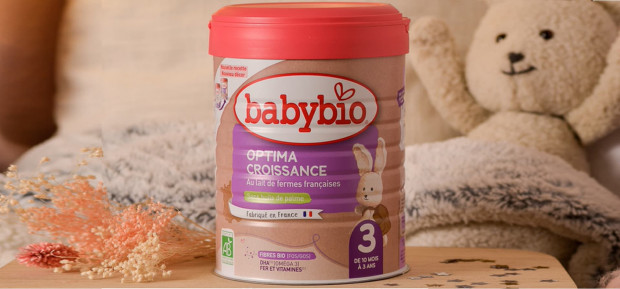The golden rules for bottle-feeding your baby
Although breastfeeding is the preferred solution for feeding your baby, it is sometimes necessary to turn to other alternatives, such as the bottle. However, bottle-feeding babies can be difficult for new parents to grasp. Calculating the right amount of milk, preparation, ideal position for bottle-feeding baby, time required? Get lots of advice from Babybio on how to bottle-feed your little one properly!
How much milk for the baby bottle?
Wondering what is the right milk dosage for your baby? Usually, it is the pediatrician (or an employee of the PMI) who will tell you how much milk is needed per bottle, depending on the baby's age and weight – and how many bottles to give per day. Most infant milks also provide indicative data by age group: for example, between 6 and 12 months, it is generally advisable to give 3 bottles of 210 ml. The packaging of your infant milk will also specify the number of pods corresponding to the amount of water to add: in most cases, 1 pod for 30 ml of water, so 7 pods are needed to prepare a bottle of 210 ml of water. This example is indicative for Babybio and may vary depending on the brands.
What water to use to prepare the bottle?
Contrary to popular belief, using bottled water to prepare the bottle is not mandatory. In most towns in France, tap water is perfectly suitable for feeding infants (however, remember to check whether the water in your town is not too mineralized). We recommend a weakly mineralized water for the reconstitution of the bottle. If you choose bottled water, opt for water marked "suitable for the preparation of infant foods".
You can consult the Ameli site which summarizes all the parameters to take into account for the preparation of a bottle.
What temperature for the bottle?
The bottle can be given at room temperature, or lukewarm (however not more than 37 degrees), depending on the baby's preferences. If you want to warm the milk, never do it in the microwave: the nutritional quality of the milk would be altered. Start by placing the powdered milk in the bottle, warm the water in the kettle or saucepan, then pour the water into the bottle, having previously checked its temperature. Shake the bottle to mix the water and the powder, and check the temperature of the milk again by placing a few drops on your wrist.
Where to give the bottle to baby?
Bottle-feeding is a special moment between you and your baby. To make your child feel calm and confident, it is important to bottle-feed him in a calm and soothing room. Talk to him softly and explain to him that it's time to treat yourself with a small bottle. If your child refuses several times, do not insist! He will ask for his meal soon enough.
How to give the bottle correctly?
Make yourself comfortable against the back of the sofa, bed or armchair. The semi-sitting position remains the most suitable. Place your baby on your lap, taking care to rest his neck in the crook of your elbow, when he is still an infant: baby should ideally be in an inclined position, facing you, so that he can look you in the eye. Possibly put your arm on a cushion or an armrest to avoid pain while you give him the bottle. Gently approach baby's bottle and gently insert the teat into his mouth – he will naturally place the teat on his tongue, against his palate. If baby falls asleep on the way, stimulate him by exerting a little pressure on his feet.
How long to give the bottle?
The time of the bottle depends on each child and the quantity of infant milk to be ingested. After 20 minutes, however, it is not necessary to insist: a baby gets tired quickly, especially when he is still very young. Conversely, do not make the baby drink too quickly: if he swallows the infant milk at full speed, pause for a few seconds to prevent him from regurgitating. On average, count about 15 minutes per bottle.
And the burp?
Burping baby after the bottle allows him to evacuate the excess air ingested during feeding. Stand him up after feeding him and position him vertically so that his face is against your shoulder. Lightly pat his back while walking. If baby doesn't burp, don't worry, it can happen!


